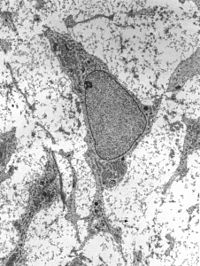
Photo from wikipedia
Background Circulating lipopolysaccharide (LPS) concentrations are often elevated in patients with sepsis or with various endogenous diseases that are associated with metabolic endotoxemia. Involuntary loss of skeletal muscle, termed muscle… Click to show full abstract
Background Circulating lipopolysaccharide (LPS) concentrations are often elevated in patients with sepsis or with various endogenous diseases that are associated with metabolic endotoxemia. Involuntary loss of skeletal muscle, termed muscle wasting, is commonly observed in these conditions, suggesting that circulating LPS might play an essential role in its development. Although impairment of muscle regeneration is an important determinant of skeletal muscle wasting, it is unclear whether LPS affects this process and, if so, by what mechanism. Here, we used the C2C12 myoblast cell line to investigate the effects of LPS on myogenesis. Methods C2C12 myoblasts were grown to 80% confluence and induced to differentiate in the absence or presence of LPS (0.1 or 1 μg/mL); TAK-242 (1 μM), a specific inhibitor of Toll-like receptor 4 (TLR4) signaling; and a tumor necrosis factor (TNF)-α neutralizing antibody (5 μg/mL). Expression of a skeletal muscle differentiation marker (myosin heavy chain II), two essential myogenic regulatory factors (myogenin and MyoD), and a muscle negative regulatory factor (myostatin) was analyzed by western blotting. Nuclear factor-κB (NF-κB) DNA-binding activity was measured using an enzyme-linked immunosorbent assay. Results LPS dose-dependently and significantly decreased the formation of multinucleated myotubes and the expression of myosin heavy chain II, myogenin, and MyoD, and increased NF-κB DNA-binding activity and myostatin expression. The inhibitory effect of LPS on myogenic differentiation was reversible, suggesting that it was not caused by nonspecific toxicity. Both TAK-242 and anti-TNF-α reduced the LPS-induced increase in NF-κB DNA-binding activity, downregulation of myogenic regulatory factors, and upregulation of myostatin, thereby partially rescuing the impairment of myogenesis. Conclusions Our data suggest that LPS inhibits myogenic differentiation via a TLR4–NF-κB-dependent pathway and an autocrine/paracrine TNF-α-induced pathway. These pathways may be involved in the development of muscle wasting caused by sepsis or metabolic endotoxemia.
Journal Title: PLoS ONE
Year Published: 2017
Link to full text (if available)
Share on Social Media: Sign Up to like & get
recommendations!